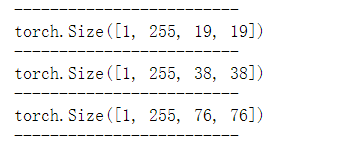
Neck和Head

发布日期:2021-05-14 15:18:18
浏览次数:21
分类:精选文章
本文共 8403 字,大约阅读时间需要 28 分钟。
1.CBL(conv+bn+LeakyRelu)
def conv2d(filter_in, filter_out, kernel_size, stride=1): pad = (kernel_size - 1) // 2 if kernel_size else 0 return nn.Sequential(OrderedDict([ ("conv", nn.Conv2d(filter_in, filter_out, kernel_size=kernel_size, stride=stride, padding=pad, bias=False)), ("bn", nn.BatchNorm2d(filter_out)), ("relu", nn.LeakyReLU(0.1)), ])) 2.SPP(SpatialPyramidPool)
class SpatialPyramidPooling(nn.Module): def __init__(self, pool_sizes=[5, 9, 13]): super(SpatialPyramidPooling, self).__init__() self.maxpools = nn.ModuleList([nn.MaxPool2d(pool_size, 1, pool_size//2) for pool_size in pool_sizes]) def forward(self, x): features = [maxpool(x) for maxpool in self.maxpools[::-1]] features = torch.cat(features + [x], dim=1) return features
3. 卷积+上采样
class Upsample(nn.Module): def __init__(self, in_channels, out_channels): super(Upsample, self).__init__() self.upsample = nn.Sequential( conv2d(in_channels, out_channels, 1), nn.Upsample(scale_factor=2, mode='nearest') ) def forward(self, x,): x = self.upsample(x) return x
4. 三次卷积块
def make_three_conv(filters_list, in_filters): m = nn.Sequential( conv2d(in_filters, filters_list[0], 1), conv2d(filters_list[0], filters_list[1], 3), conv2d(filters_list[1], filters_list[0], 1), ) return m
5.五次卷积块
def make_five_conv(filters_list, in_filters): m = nn.Sequential( conv2d(in_filters, filters_list[0], 1), conv2d(filters_list[0], filters_list[1], 3), conv2d(filters_list[1], filters_list[0], 1), conv2d(filters_list[0], filters_list[1], 3), conv2d(filters_list[1], filters_list[0], 1), ) return m
6.最后的Head输出
def yolo_head(filters_list, in_filters): m = nn.Sequential( conv2d(in_filters, filters_list[0], 3), nn.Conv2d(filters_list[0], filters_list[1], 1), ) return m
7.HEAD构建
class YoloBody(nn.Module): def __init__(self, num_anchors, num_classes): super(YoloBody, self).__init__() # backbone self.backbone = darknet53() self.conv1 = make_three_conv([512,1024],1024) self.SPP = SpatialPyramidPooling() self.conv2 = make_three_conv([512,1024],2048) self.upsample1 = Upsample(512,256) # 上采样 self.conv_for_P4 = conv2d(512,256,1) self.make_five_conv1 = make_five_conv([256, 512],512) self.upsample2 = Upsample(256,128) self.conv_for_P3 = conv2d(256,128,1) self.make_five_conv2 = make_five_conv([128, 256],256) # 3*(5+num_classes)=3*(5+20)=3*(4+1+20)=75 # 4+1+num_classes final_out_filter2 = num_anchors * (5 + num_classes) self.yolo_head3 = yolo_head([256, final_out_filter2],128) self.down_sample1 = conv2d(128,256,3,stride=2) # 下采样 self.make_five_conv3 = make_five_conv([256, 512],512) # 3*(5+num_classes)=3*(5+20)=3*(4+1+20)=75 final_out_filter1 = num_anchors * (5 + num_classes) self.yolo_head2 = yolo_head([512, final_out_filter1],256) self.down_sample2 = conv2d(256,512,3,stride=2) self.make_five_conv4 = make_five_conv([512, 1024],1024) # 3*(5+num_classes)=3*(5+20)=3*(4+1+20)=75 final_out_filter0 = num_anchors * (5 + num_classes) self.yolo_head1 = yolo_head([1024, final_out_filter0],512) def forward(self, x): # backbone x2, x1, x0 = self.backbone(x) P5 = self.conv1(x0) P5 = self.SPP(P5) P5 = self.conv2(P5) P5_upsample = self.upsample1(P5) P4 = self.conv_for_P4(x1) P4 = torch.cat([P4,P5_upsample],axis=1) P4 = self.make_five_conv1(P4) P4_upsample = self.upsample2(P4) P3 = self.conv_for_P3(x2) P3 = torch.cat([P3,P4_upsample],axis=1) P3 = self.make_five_conv2(P3) P3_downsample = self.down_sample1(P3) P4 = torch.cat([P3_downsample,P4],axis=1) P4 = self.make_five_conv3(P4) P4_downsample = self.down_sample2(P4) P5 = torch.cat([P4_downsample,P5],axis=1) P5 = self.make_five_conv4(P5) out2 = self.yolo_head3(P3) out1 = self.yolo_head2(P4) out0 = self.yolo_head1(P5) return out0, out1, out2
测试
# 随机生成输入数据rgb = torch.randn(1, 3, 608, 608)# 定义网络net = YoloBody(3, 80)# 前向传播out = net(rgb)# 打印输出大小print('-----'*5)print(out[0].shape)print('-----'*5)print(out[1].shape)print('-----'*5)print(out[2].shape)print('-----'*5) 
Head的Decode层
预测框和真实框进行iou计算
1.yolo_decode
# output:(B,A*n_ch,H,W) ---> (B,A,H,W,n_ch)def yolo_decode(output, num_classes, anchors, num_anchors, scale_x_y): device = None cuda_check = output.is_cuda if cuda_check: device = output.get_device() n_ch = 4+1+num_classes # n_ch == [tw,ty,tw,th,obj,class] A = num_anchors B = output.size(0) H = output.size(2) W = output.size(3) # (B,A,n_ch,H,W) ---> (B,A,H,W,n_ch) output = output.view(B, A, n_ch, H, W).permute(0,1,3,4,2).contiguous() bx, by = output[..., 0], output[..., 1] bw, bh = output[..., 2], output[..., 3] det_confs = output[..., 4] cls_confs = output[..., 5:] bx = torch.sigmoid(bx) by = torch.sigmoid(by) bw = torch.exp(bw)*scale_x_y - 0.5*(scale_x_y-1) bh = torch.exp(bh)*scale_x_y - 0.5*(scale_x_y-1) det_confs = torch.sigmoid(det_confs) cls_confs = torch.sigmoid(cls_confs) grid_x = torch.arange(W, dtype=torch.float).repeat(1, 3, W, 1).to(device) grid_y = torch.arange(H, dtype=torch.float).repeat(1, 3, H, 1).permute(0, 1, 3, 2).to(device) bx += grid_x by += grid_y for i in range(num_anchors): bw[:, i, :, :] *= anchors[i*2] bh[:, i, :, :] *= anchors[i*2+1] bx = (bx / W).unsqueeze(-1) by = (by / H).unsqueeze(-1) bw = (bw / W).unsqueeze(-1) bh = (bh / H).unsqueeze(-1) #boxes = torch.cat((x1,y1,x2,y2), dim=-1).reshape(B, A*H*W, 4).view(B, A*H*W, 1, 4) boxes = torch.cat((bx, by, bw, bh), dim=-1).reshape(B, A * H * W, 4) det_confs = det_confs.unsqueeze(-1).reshape(B, A*H*W, 1) cls_confs =cls_confs.reshape(B, A*H*W, num_classes) # confs = (det_confs.unsqueeze(-1)*cls_confs).reshape(B, A*H*W, num_classes) outputs = torch.cat([boxes, det_confs, cls_confs], dim=-1) #return boxes, confs return outputs
class YoloLayer(nn.Module): ''' Yolo layer model_out: while inference,is post-processing inside or outside the model true:outside ''' def __init__(self, img_size, anchor_masks=[], num_classes=80, anchors=[], num_anchors=9, scale_x_y=1): super(YoloLayer, self).__init__() #[6,7,8] self.anchor_masks = anchor_masks #类别 self.num_classes = num_classes # if type(anchors) == np.ndarray: self.anchors = anchors.tolist() else: self.anchors = anchors print(self.anchors) print(type(self.anchors)) self.num_anchors = num_anchors self.anchor_step = len(self.anchors) // num_anchors print(self.anchor_step) self.scale_x_y = scale_x_y self.feature_length = [img_size[0]//8,img_size[0]//16,img_size[0]//32] self.img_size = img_size def forward(self, output): if self.training: return output in_w = output.size(3) anchor_index = self.anchor_masks[self.feature_length.index(in_w)] stride_w = self.img_size[0] / in_w masked_anchors = [] for m in anchor_index: masked_anchors += self.anchors[m * self.anchor_step:(m + 1) * self.anchor_step] self.masked_anchors = [anchor / stride_w for anchor in masked_anchors] data = yolo_decode(output, self.num_classes, self.masked_anchors, len(anchor_index),scale_x_y=self.scale_x_y) return data
测试
import osimport numpy as np
def get_anchors(): anchors_path = os.path.expanduser('yolo_anchors_coco.txt') with open(anchors_path) as f: anchors = f.readline() anchors = [float(x) for x in anchors.split(',')] print(anchors) return anchors anchors = get_anchors()

yolo_decodes = []anchor_masks = [[0,1,2],[3,4,5],[6,7,8]]for i in range(3): head = YoloLayer((608, 608, 3), anchor_masks,80, anchors, len(anchors)//2).eval() yolo_decodes.append(head)

output_list = [] # 存放解码后的输出预测for i in range(3): output_list.append(yolo_decodes[i](out[i]))output = torch.cat(output_list, 1)print(output.shape)


发表评论
最新留言
路过,博主的博客真漂亮。。
[***.116.15.85]2025年04月28日 00时37分07秒
关于作者

喝酒易醉,品茶养心,人生如梦,品茶悟道,何以解忧?唯有杜康!
-- 愿君每日到此一游!
推荐文章
海思SDK mkimage command not found
2021-05-15
QT5 退出窗口
2021-05-15
ov9732 datasheet
2021-05-15
rk3399平台gt9xx触摸屏驱动分析
2021-05-15
X工厂 ERP (SBO) 2006 项目案例
2021-05-15
Android 吸顶布局
2021-05-15
python学习笔记2.3- 循环、判断
2021-05-15
python学习笔记4.1-python高级之生成器
2021-05-15
U3D实现WebCamera显示
2021-05-15
方法的重载
2021-05-15
SpringCloud第七章Ribbon负载均衡服务调用
2021-05-15
Python我的模块-字符替换
2021-05-15
"cannot be resolved or is not a field"问题解决
2021-05-15
Android Eclipse svn插件安装说明
2021-05-15
Android判断是否是平板
2021-05-15
C++中的字节对齐,以及空结构体,数组,union类型的实践
2021-05-15
"compileDebugJavaWithJavac"错误解决
2021-05-15